(95-1) 8 398 433, 8 398 455
uatours@uniqueasiatravel.com

Bagan
Bagan is the main tourist attraction in Myanmar and one of the richest archaeological sites in Asia. The old city located on the eastern bank of the Ayeyarwaddy River. It covers 42 sq. km containing over 2000 well-preserved pagodas and temples of the 11th-13th century.
Bagan was the seat of power of the First Empire of Myanmar, founded by King Anawrahta, which extended to the border of present day Cambodia. The majestic temples and golden pagodas are symbols of the time when Theravada Buddhism first flourished in the country, after King Anawrahta gave it full support in the 11th century. Some scholars think that the temples were made of bricks baked in kilns fired by wood from trees felled around Bagan, which transformed the once lush area to arid land. However, early records described Bagan as already being a hot, dry area. Bricks found at Bagan often bear stamps showing the names of towns or villages many miles away in every direction.
Getting there to Bagan
There are daily flights between Yangon and Bagan and it takes just an hour to get there. Another way to get there is the Express bus service from Yangon which takes around 15 hours. There also have regular flights from Mandalay and Heho. You can also take a train from Yangon to Bagan. There is a double-decker steamer service between Mandalay and Bagan and there has some express boats Shwe Kannari and Malikha accordingly to the season and weather.
Sightseeing around Bagan
Shwezigon Pagoda
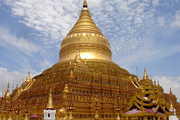 The golden-domed pagoda was left unfinished on King Anawrahta’s death and completed by his successor, King Kyansit-tha on 1087, enhanced his mentor’s legacy with peace and unity between the Burma (Burmese) and other national races. On the Shwezigon platform, there is a pavilion with carved scenes in high relief of the Jataka tales.
The golden-domed pagoda was left unfinished on King Anawrahta’s death and completed by his successor, King Kyansit-tha on 1087, enhanced his mentor’s legacy with peace and unity between the Burma (Burmese) and other national races. On the Shwezigon platform, there is a pavilion with carved scenes in high relief of the Jataka tales.
Ananda Temple
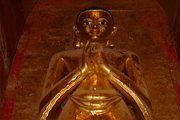 The one of the most beautiful temples built after the Shwezigon in 1090 by King Kyansit-tha. It is the masterpiece of the early style temple architecture. The corridors are lined with glazed-clay plaques portraying scenes from Jataka tales and Buddha’s life. There are 1447 plaques and they are the best of those Bagan. Nowhere else in the world is the Buddha’s biography depicted in such detail at a pagoda. Of its four 32ft (9.7m)high wooden images, those on the north and south are originals. The other two are replacements made more than two-hundred years ago after the originals were destroyed by fire or theft.
The one of the most beautiful temples built after the Shwezigon in 1090 by King Kyansit-tha. It is the masterpiece of the early style temple architecture. The corridors are lined with glazed-clay plaques portraying scenes from Jataka tales and Buddha’s life. There are 1447 plaques and they are the best of those Bagan. Nowhere else in the world is the Buddha’s biography depicted in such detail at a pagoda. Of its four 32ft (9.7m)high wooden images, those on the north and south are originals. The other two are replacements made more than two-hundred years ago after the originals were destroyed by fire or theft.
Thatbyinnyu Temple
 The Thatbyinnyu Temple, a white stucco building, is the Bagan’s highest pagoda. It was built by King Alaungsithu in mid-12th century. The view from its terraces is spectacular both at dawn and dusk.
The Thatbyinnyu Temple, a white stucco building, is the Bagan’s highest pagoda. It was built by King Alaungsithu in mid-12th century. The view from its terraces is spectacular both at dawn and dusk.
Gawdawpalin Temple
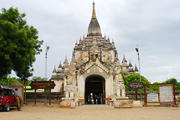 This 13h century temple is like Thatbyinnyu, about 60 metres high with a fine view of the Bagan plains. The templs was built by King narapati Sithu and it is said, to seek pardon with an obeisance for insulting the memory of his forefathers. Gawtaw means the act of obeisance and palin means throne.
This 13h century temple is like Thatbyinnyu, about 60 metres high with a fine view of the Bagan plains. The templs was built by King narapati Sithu and it is said, to seek pardon with an obeisance for insulting the memory of his forefathers. Gawtaw means the act of obeisance and palin means throne.
Dhamayangyi Temple
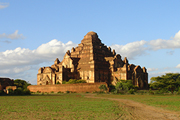 Bagan’s most massive temple, Dhammayangyi Temple was built by King Narathu in 1167. This temple was not finished but it displayed the finest brickwork. The mortar holding the bricks is so thin it is barely visible but so strong that even during earthquakes the temple remained unscathed. Inside the temple is a round stone with a hollow in the shape of an arm, complete with bended elbow and a narrow trench across where the wrist would be. It is said that Narathu used this stone to cut off the hands of masons who applied too thick a layer of mortar.
Bagan’s most massive temple, Dhammayangyi Temple was built by King Narathu in 1167. This temple was not finished but it displayed the finest brickwork. The mortar holding the bricks is so thin it is barely visible but so strong that even during earthquakes the temple remained unscathed. Inside the temple is a round stone with a hollow in the shape of an arm, complete with bended elbow and a narrow trench across where the wrist would be. It is said that Narathu used this stone to cut off the hands of masons who applied too thick a layer of mortar.
Gubyaukgyi Temple
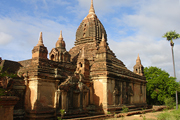 This early 13th century temple displays a strong influence of Indian culture. Inside are the wall paintings and 28 Buddha images in sitting position.
This early 13th century temple displays a strong influence of Indian culture. Inside are the wall paintings and 28 Buddha images in sitting position.
Shwesandaw Pagoda
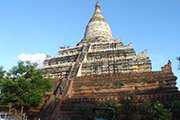 This pagoda built by King Anawrahta in early 11th century displays a strong Mon influence with a steep stairway directly to the terraces for a superb view from the upper level. Visitors like to climb up the western face to view sunsets and there is a handrail for safety.
This pagoda built by King Anawrahta in early 11th century displays a strong Mon influence with a steep stairway directly to the terraces for a superb view from the upper level. Visitors like to climb up the western face to view sunsets and there is a handrail for safety.
Sulamani Temple
 This temple built in 1181 by King Narapatisithu and is known for its murals dating from 11th-12th century. The red-brick temple features delicate masonry work. During the reign of Narapati Sithu, culture, arts and language flourished and the Myanmar language become polished and elegant. In Narapati Sithu’s time the country’s name “Mranma” was first etched on a stone inscription of 1190CE, a name that survives to this day.
This temple built in 1181 by King Narapatisithu and is known for its murals dating from 11th-12th century. The red-brick temple features delicate masonry work. During the reign of Narapati Sithu, culture, arts and language flourished and the Myanmar language become polished and elegant. In Narapati Sithu’s time the country’s name “Mranma” was first etched on a stone inscription of 1190CE, a name that survives to this day.
Bu Paya
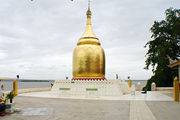 Not far from the Gatawpalin is a pagoda spire in the shape of a gourd(bu), after which it was named. It stands on a platform overlooking the Ayeyarwaddy River, and is one of the jetties for Bagan. This is a replica because the original collapsed into the river during the 1975 earthquake that damaged many temple.
Not far from the Gatawpalin is a pagoda spire in the shape of a gourd(bu), after which it was named. It stands on a platform overlooking the Ayeyarwaddy River, and is one of the jetties for Bagan. This is a replica because the original collapsed into the river during the 1975 earthquake that damaged many temple.
Other interesting sites around Bagan
Mount Popa
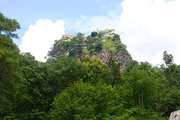 About 30 miles (50 km) southeast of Bagan, Mount Popa or Popa Taung Kalat located. It is 1,500 metres high and an extinct volcano. Its is legendary home of the ‘nats’ or spirits. The Mount Popa are has also been designated as a National Park, a perfect place for eco-tourism.
About 30 miles (50 km) southeast of Bagan, Mount Popa or Popa Taung Kalat located. It is 1,500 metres high and an extinct volcano. Its is legendary home of the ‘nats’ or spirits. The Mount Popa are has also been designated as a National Park, a perfect place for eco-tourism.
A few yards from the foot of the mountain is the shrine of Min Maha Giri, Lord of the Mountain, and his family of Spirits. He is the protector of hous, town or city. He and his sister, Lady Golden Face, guard the Tharaba Gate of Bagan, with their images on either side.
Sale (Sa-Lay)
 It is a small town about 15km south of Bagan, down the Ayeyarwaddy River. U Pone Nya Museum, formerly the Yoke Sone Monastery, exhibits antique laquerwares, wooden reliefs and a large standing gilded Buddha image. The figures carved outside the front of the building are worth seeing. Another place worth visiting is Tha-ta-na Kyaung (Keythar monastery) where Tripitaka texts are housed in a large red lacquered cabinet.
It is a small town about 15km south of Bagan, down the Ayeyarwaddy River. U Pone Nya Museum, formerly the Yoke Sone Monastery, exhibits antique laquerwares, wooden reliefs and a large standing gilded Buddha image. The figures carved outside the front of the building are worth seeing. Another place worth visiting is Tha-ta-na Kyaung (Keythar monastery) where Tripitaka texts are housed in a large red lacquered cabinet.
Contact Us
No.152, Sule Pagoda Road, Kyauktada Township, Yangon, Myanmar.
(95-1) 8 398 433, 8 398 455, 8 398 499
24hrs hotline : (95-9) 540 2525, 540 2727, 540 2929

